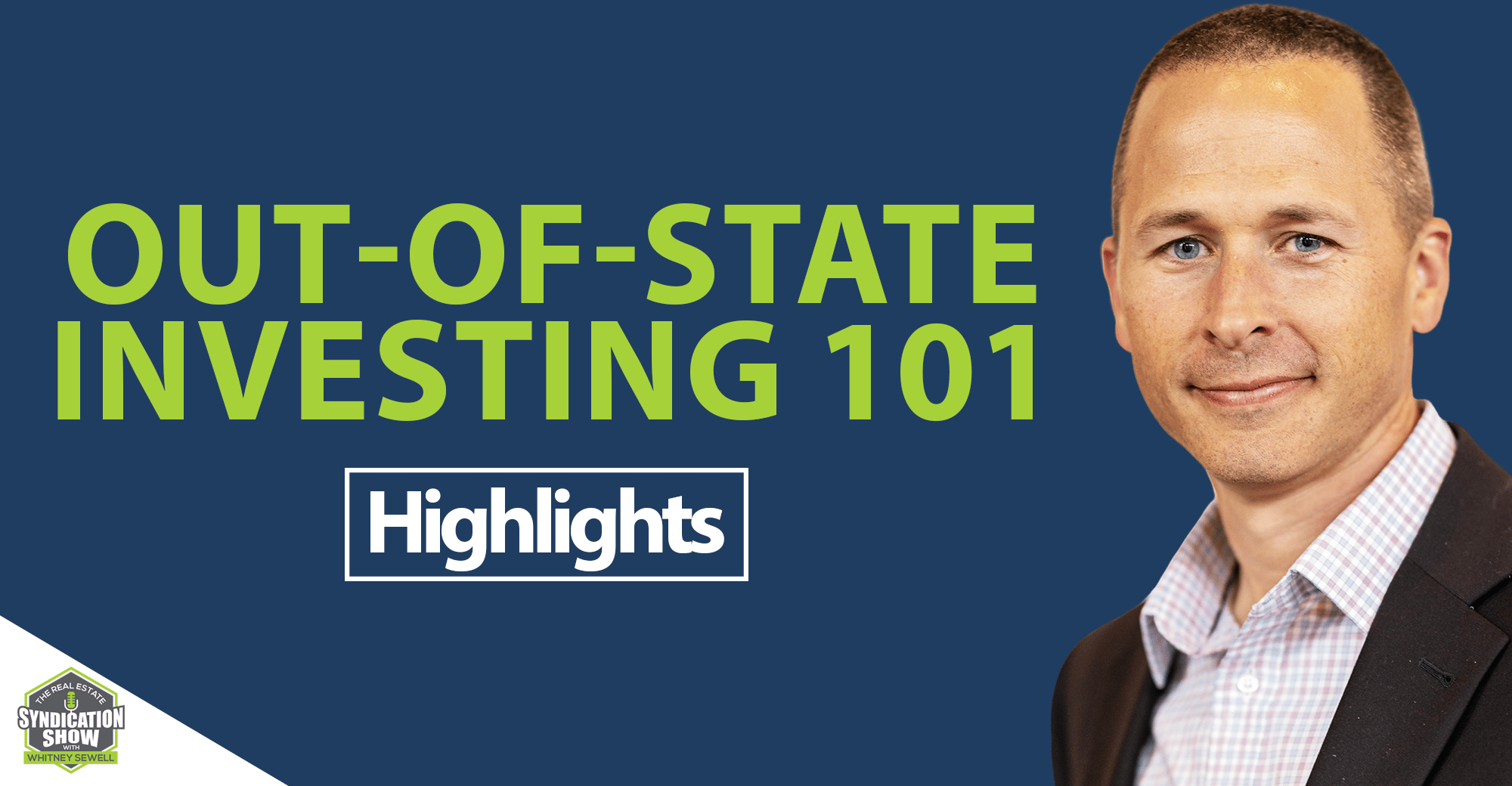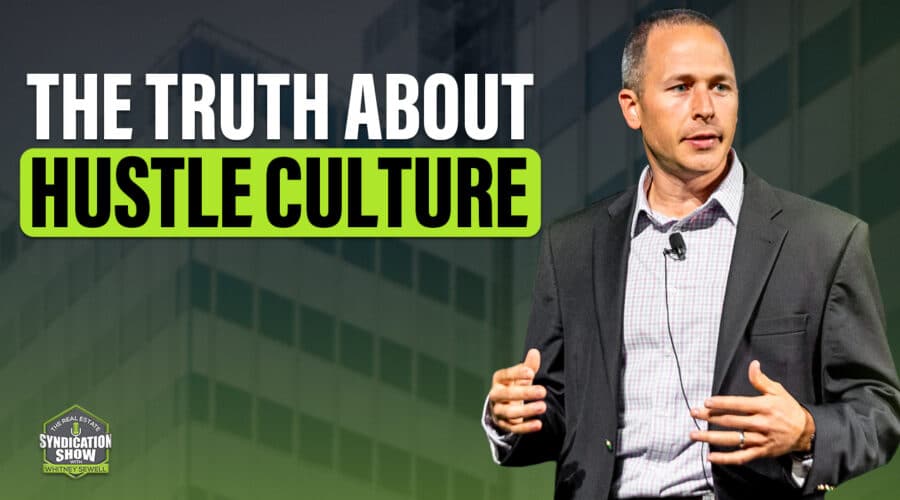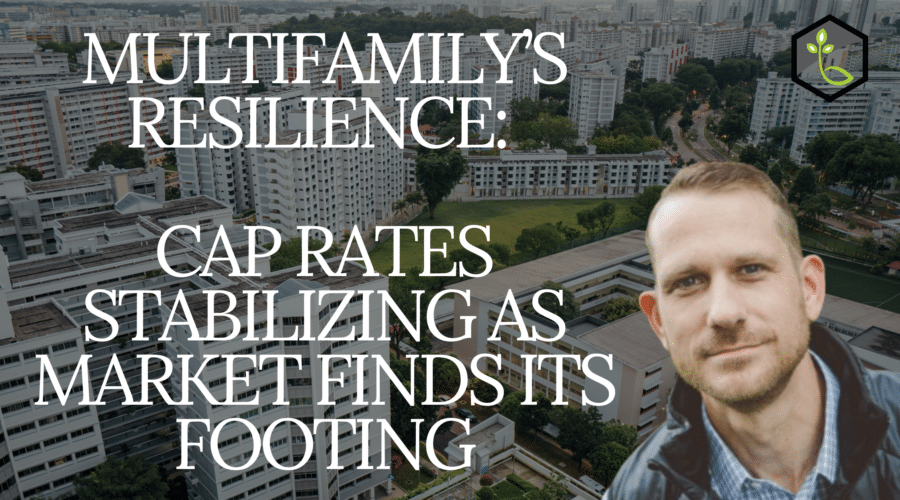
It is reasonable to feel anxious about investing in a project that one has never seen such as in the likes of out-of-state investing. In this #Highlights episode, we look back at our conversations with real estate entrepreneurs Logan Freeman and Jay Tenenbaum. The two talk about everything you need to know about out-of-state investing.
Watch the episode here:
Listen to the podcast here:
Logan helps us understand how out-of-state investments work and how to do it successfully. Meanwhile, Jay talks about how he successfully invested in mortgage notes in out-of-state properties and managed an out-of-state rental port. Click the play button and start learning about out-of-state investing!
Key Points From This Episode:
- Logan elaborates on the four things that out-of-state investors need to know.
- The need to have clear expectations.
- Why is communication important?
- Why do you need to think about the agency you are working with?
- Logan says everything should be clear upfront when investing out-of-state.
- Jay shares how he got into mortgage note investing.
- Jay explains why he focuses on secondary markets.
- What are the risks of non-performing notes? How long can you expect a return when you invest in a note?
- Jay discusses foreclosures and how it affects investment.
- Jay shares his key to success in managing his out-of-state investments – building a strong team.
Tweet This!
“When I tell my friends, family, whoever, what I do is they say, ‘You go buy houses and apartments?’ I said, ‘No, I buy income streams.’ That’s what we purchased.” – Logan Freeman
“The key to success (in out-of-state investing) is building a strong team.” – Jay Tenenbaum
“Your team building usually starts with finding that good realtor who likes working with investors, who has the connections or their own contracting crew already.” – Jay Tenenbaum
Links Mentioned:
WS219: Making An Out-Of-State Investment with Logan Freeman
Scottsdale Real Estate Investments website
WS1004: Investing Out-Of-State With Jay Tenenbaum
About Logan Freeman

Logan is a real estate investor, developer, and agent who has found his niche in the industry acting as an investment property specialist and actually representing buyers instead of sellers in the transaction process.
Logan has also completed multiple joint venture projects, and equity partnerships and works as a developer. Completing over 120 transactions in less than a year, Logan has found a process and relies on his most valuable priorities to guide his profit-producing activities.
Logan is a husband, and father to a brand new baby girl. Logan is located in Kansas City Missouri and can be found at livefreeinvestments.com
About Jay Tenenbaum

In his career, Jay has acquired over 450 distressed mortgage notes and real property in more than 30 states. Jay attributes his success and expertise to his ability to effectively integrate 20 years of experience as a former debt collection professional. Jay’s legal know-how and achievement in resolution in turning non-performing assets into positive cash flow give him an unmatched perspective in this field. He is a nationally recognized speaker and expert in discounted mortgages and real estate investing. Jay is a sought-after speaker at investment conferences across the country for his proficiency in these topics.
Full Transcript
EPISODE 1497
[INTRODUCTION]
Whitney Sewell (WS): This is your Daily Real Estate Syndication Show and I’m your host, Whitney Sewell. Today we packed a number of shows together to give you some highlights. I know you’re gonna enjoy this show. Thank you for being with us today!
[INTERVIEW]
WS: Our guest is Logan Freeman. Thanks for being on the show.
Logan Freeman (LF): I’m super excited to be here, Whitney.
WS: Your businesses have changed a little bit. You’ve grown, you’re doing bigger deals, you’re working with investors and you’re syndicating deals. I appreciate you again sharing this experience. One expertise you have is working with investors and helping them to invest from out of state successfully. Let’s dive into that a little bit and tell me some of those problems and how you helped them.
LF: There are four things that I try to help out-of-state investors understand or even agents that are working with out-of-state investors. When I tell my friends, family, whoever, what I do is they say, “You go buy houses and apartments?” I said, “No, I buy income streams.” That’s what we purchased. We don’t care what it looks like, not to an extent. Understanding the math behind that. When I think about an out-of-state investor, it’s scary for somebody like that to be placing capital into sometimes a project that they’ve never even seen. You understand that many of your investors, many of my investors have never seen the property. You’re focused on building that trust and rapport on the phone.
The only way to do that what I’ve found is to do what you’re going to say you’re going to do and be honest and you get everything out upfront. What I call that number one is clear expectations. When I ask the buyer, “What were you going to need to feel comfortable to move forward on this purchase?” I don’t want you to put an offer in until we get the documents that you need to work through. We need to run down what the taxes are going to be, what the insurance. We need to talk to a property manager, we need to look at lease rolls and rent rolls. That’s fine, but I take a backward approach where I definitely don’t want to do that stuff after we’re under contract. My close rate is right around 90% of my transactions because of this. I might lose a couple of deals and that’s fine because I’m not giving an offering, but at the same time, I’m not wasting the seller’s time. I’m not wasting the buyer’s time because we have clear expectations going in. Not only has that helped me with my investors out of state, but it has also helped me with my reputation here in the Kansas City market. We perform and we are closer. That’s number one. Do you have any questions before we move on to number two on that?
WS: Do what you say you’re going to be upfront. You’re asking them questions like what you are going to need to move forward and putting it out there. Letting them know they can ask questions because if you don’t ask, they may not even pursue the deal at all.
LF: We get down many days into the transaction and you’ve got $5,000 in inspections, you’ve got all this time, effort and energy and we find something that we could have had before we even went under contract. It’s a much easier way to think about it, but it’s also backward whenever you think of a regular real estate agent. All they want to do is get something under contract and then try to figure it out. That’s not my approach. That’s the first one is those clear expectations. Number two I’m going to say is communication. There’s another great book that I cannot recommend enough and it’s from Chris Voss, Never Split the Difference. He calls it a negotiating book, I would call it a communication book. That and Crucial Conversations and those two books have helped me have tough conversations with people and get things out on the table, not only from the seller side but the buyer side.
One example I’ll give you that bit me in the rear is we were working on a transaction of 32 properties. It’s about a $2.5 million, $2.6 million purchase. It was a lot of properties. Basically, I forgot to ask the buyer. The buyer had done a good job of winning me over by showing me their track records, showing me what they have done in the past. What I forgot to ask. There are two issues here. One is what their structure was on their syndication because I didn’t even know they were going to be syndicating this deal. I thought he was a buyer outright. Number two, what are the expectations on that structure to his investors? That was a big piece because we got down the road many days into the transaction. I underwrote the deal and he put it into his model and couldn’t figure out why we were not getting the right type of stuff and it was all because of the structure. Communication up front with your investor on what they’re trying to accomplish. Starting with the end in mind, how they’re going to get there and if they’re buying it outright or they’re going to go source capital as well. That would be number two.
Number three, if you’re working with an out-of-state investor, an investor needs to think about the agent that they’re working with. They need to be willing to pay upfront. Here’s what I mean by that. Not pay the agent but pay to find some marketing dollars to get out there into the marketplace. The agents here are only as good as the network that they have. If somebody is serious about coming into a market like Kansas City and they have a specific property type that they want to work with. Multiple times in the past, I’ve been able to dial in using my resources: Reonomy, CoStar and property parcel records. I’ll create an awesome list, but that’s not necessarily my job to call that list or market to that list.
The last thing to get everything cleared up front so you can perform. This piggybacks on number one. For example, I’ve got a listing on a 32-unit property and I’m telling those buyers that are contacting me on it. “I don’t think it’s good for us to put an offer in until you have done the whole process that you can perform.” This is where I asked for, “Where do you own other properties? Have you syndicated before? Do you own anything outright? What is it going to take for you to perform?” I have them talk to the local bank that we’ve done multimillion-dollar transactions with and say, “Can you underwrite this person for me and see if they’re a real deal?”
[INTERVIEW 2]
Sam Rust (SR): We are joined by Jay Tenenbaum. Jay is with Scottsdale Real Estate Investments and has acquired over 450 distressed mortgage notes and real property in more than 30 states in his real estate career. Jay has a background in the legal field as well. We’re excited to have him on the show. Thanks for joining us, Jay.
Jay Tenenbaum (JT): Thank you, Sam. Well, pleased to be here.
SR: Excellent. Jay, I wonder if maybe we could start with how you got into mortgage notes. As we’re chatting before the show, you mentioned you’d been in the legal field working in debt collection for a number of years and then you transitioned into mortgage notes, what was that journey like? How are you where you are today?
JT: Sure. So first of all, I’d like to say I’ve been in debt all my life – just not personally, so I was a debt attorney for 20 years. 2009 and 2012 started investing in buying judgment liens in California and executing our real property, and then late 2013 got went…you know, got exposed to, you know, mortgage note investing, and it was an easy transition. Just know the debt instrument, you know, different debt instrument and made that transition very swiftly.
SR: Oh, that’s excellent. You guys focus on secondary markets, I’m curious why you guys have picked those markets? What you would call a secondary market? And why that works for you and your team?
JT: Sure. So secondary markets are, first of all, two fold it is. One is, we are buying distressed mortgage notes. Okay, for example, Bank of America, Morgan…JP Morgan Chase whatever, which in the loan do you back whenever, right, and then you sell it, they sell it on the market five minutes later. And they sell it some hedge fund who strokes at 78-figured check which then sells to another hedge fund for $95 more, and ultimately trickles down to smaller ventures such as ourselves, where up ’til now the loan is just been in default and nobody’s talk to borrow, nobody’s tryin’ to foreclosure, nobody’s doing anything, and so we pick it up. We go like, I say like star track, will…no one’s got them before, well actually work it though, whether we’re speaking to the borrower or sort of foreclosure.
SR: So you guys specialized in non-performing notes, is that correct?
JT: Correct, because for starters…well, because of my background I can, and in the very beginning, buying you know, low, what we call low balance assets, meaning the houses in those areas were worth $50,000 give or take, right? We’re buying these loans like you know, 5, 10,000 dollars, and you’re having conversations with borrowers and all of a sudden, you know, you’re making a $3 a month, you know, low modification payment. Your return on investment’s awesome, right? And so if you think about it, if I’m buying a note for 10 grand, and if you get $300 payment, I’m getting a 36% return annually, right? I’ve turned that non-performing loan into a value add performing loan, right. Now, the performing market probably paying 25, 30,000 dollars for that or more, so my return is not its great. I’m paying the premium for the gains and cash flow. You know, because my background it’s easy for me to do it.
Going back to what you said before with regards to secondary markets, I also establish my forte where I lived in…when I start investing I lived in California, I moved here in Arizona about four years ago, I’ve never bought anything whether where I live, whether it’s California or Arizona. So I always learn how to buy stuff out of state because in the Midwest and South primarily that’s where the better opportunities exist – you’re in judicial foreclosure states so the process takes longer, but ultimately you get your better discount because of that. You know California, you know Arizona are either trust states, or mortgage foreclosure states five minutes, and for that you’re gaining premium for.
SR: Yeah. And so, what are the risks? And what’s the typical investor profile? You guys work with people from around the country, you know, there are pros and cons, I mean you kinda outline there’s better yield in a non-performing note, are you guys taking strictly first position notes? And if so, how do you ameliorate the risk? If you’re taking the second position, you know, it can take a lot longer to online, say you can’t get a note performing, maybe you have to go to that foreclosure process, how long does it take to actually realize a gain?
JT: Sure. So, first of all a couple things. Number one, I only invest in first, there are various reasons why not second, one is better being first than second. But second is just the marketplace was atrocious. When I first started the sellers in the industry weren’t that reputable, plus there was much, much, much more risk involve in second, you gotta admit it’s deeper discounts but there was so much more risk, risking involve. With regards to buying first, the foreclosure process is in judicial states takes anywhere from, could be six months to a year but thing is, the key is you want to minimize your risk, meaning we started out buying pools of assets like I’ll buy three, four, five, ten, the largest pool ever bought was like 40 assets at one point at a time. So you minimize your risk that way because the diversification you achieve. Number one…so that’s one of the reasons that we diversify, buying first and buying then diversifying. I bought pools before where I made one phone call and started generate cash, I’ve done it so many times, a couple of different pools where I got them the majority, you know, very, very quickly. We bought 21 seller finance notes in September of 2018 for $85,000 total, right, it was a hedge fund that I bought about 120 assets from earlier, they were getting out the very last, last, little bit last. And almost immediately reached out to…got about 13 of those 15, 14 performings immediately spinning off about five grand a month, almost immediately right out the door. So yeah, you can generate the cash flow.
Now, I also, if I may add, you guys, your backstop. What I mean by that is when the borrower can’t get out of their own, you have to start the foreclosure. I started aggressively, only the backstops. If I’m talking to you and you talking about service everything else, the loan just can continuously fall and my ROI goes down, right? So as I set the backstop, now my action creates your action.
SR: I know in the multifamily world which is where we play a little bit more, if we as the landlord don’t hold up our end of the lease in holding the tenant to the terms of the lease, so it’s beyond just “Hey, we didn’t provide a clean place of habitation,” but if we don’t initiate eviction proceedings within a certain window unless there are extenuating circumstances like the moratorium, then we’re in default of the lease or breaking the lease and we can’t enforce its provisions on the tenants. Is it kind of the same methodology for foreclosures?
JT: Well other than moratoriums, is really the investor, the lender’s call, right. When you’re buying notes you are…you step in the shoes of a lender. You are the lender per se, it’s your call. Those who sit around and don’t do it, I think you’re just doing disservice because if the loan’s not performing, you’re not foreclosing, what are you doing? The loan doesn’t automatically start generating cash flow in the shelf, right, it just has got to do something. And I know I’ve talked to certain investors like “Well, let’s spend money to do it, you know, buy them over two grand.” Okay, but it’s not doing anything. It’s only two grand, you risk to minimize your investment style huge, but it’s not doing anything. She put a little money into it, you start foreclosure and get the money back, because most states the foreclosure of these are recoverable, and now you generate some reaction by the borrower and you know, who knows? They just like, you know, when a tenant just runs and jumps up and paste the past two rent, right, though you have those kinds of tenants. You know, you gotta almost threaten eviction over or tenement eviction before they went up and pay, well that same thing happens here.
SR: Makes a lot of sense. Coming into managing all these properties, I mean you’re in Phoenix, you’re acquiring these properties around the country primarily said in the Midwest and in the south, what are some systems that you put in place? What are some tricks that maybe our audience could use? There are a lot of folks that are investing out of state it might not be in notes, specifically but what has been key to your success in managing these assets?
JT: The key to that success is building a strong team in those markets. I’ve kissed a few frogs along the way, you know, finding the right team members, right? I found on balance trying to find the national vendors, you know, national property preservation guys, you know, national this, national that, just don’t really work out because all they’re doing is farming gets a lot of affiliates anyway. You might as well go directly engage local affiliates in a market.
Your team building usually starts with finding that good realtor who likes working with investors, who has the connections or their own contracting crew already. Secondarily, even if you’re not even buying rentals, a property manager knows everybody anyway, and that pretty much afford you, there are routine starts. Now with Scottsdale we’ve grown, we’ve added team members to kind of oversee that, like which is Apple we have our own project manager now in-house to deal with the local building local teams himself, right? It just takes the burden off of us, although we’ve got some very strong teams and some very strong here in New Orleans, Pittsburgh, you know, we got extremely sound team members.
[END OF INTERVIEW]
[OUTRO]
Whitney Sewell: Thank you for being with us again today. I hope that you have learned a lot from the show. Don’t forget to like and subscribe. I hope you’re telling your friends about Real Estate Syndication Show and how they can also build wealth in real estate. You can also go to LifeBridgeCapital.com and start investing today.
[END]
Love the show? Subscribe, rate, review, and share!
Join the Real Estate Syndication Show Community:




